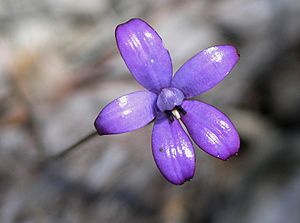Purple enamel orchid facts for kids
Quick facts for kids Purple enamel orchid |
|
|---|---|
 |
|
| Scientific classification | |
| Genus: |
Caladenia
|
| Species: |
brunonis
|
| Synonyms | |
|
|
The Caladenia brunonis, also known as the purple enamel orchid, is a beautiful flower. It belongs to the orchid family and grows only in the south-west part of Western Australia. This special ground orchid has a single flat, hairy leaf. It also has up to three shiny purple flowers. For a while, it was called Elythranthera brunonis, but scientists recently found that it fits better into the Caladenia group.
What Does It Look Like?
The purple enamel orchid is a plant that grows from the ground. It is a perennial plant, meaning it lives for more than two years. It's also deciduous, so it loses its leaves at certain times. This orchid has a few small, thin roots. It also has a tuber, which is like a small underground storage part. This tuber is protected by a tough, layered cover.
The orchid has one flat, dark green leaf. This leaf is hairy and can be about 20–80 mm (0.8–3 in) long and 7 mm (0.3 in) wide. The underside of the leaf is a reddish-purple color.
The plant grows a tall stem, about 150–300 mm (6–10 in) high. On this stem, you can find up to three shiny purple flowers. Each flower is about 20–30 mm (0.8–1 in) long and 10–30 mm (0.4–1 in) wide.
The different parts of the flower spread out. The sepals and petals have blackish tips. They also have red or purple blotches on their backs.
- The top sepal, called the dorsal sepal, stands straight up. It is about 16–20 mm (0.6–0.8 in) long and 6–8 mm (0.2–0.3 in) wide.
- The side sepals, called lateral sepals, and the petals are about 14–18 mm (0.6–0.7 in) long and 6–8 mm (0.2–0.3 in) wide.
The labellum is a special lip-like part of the flower. It is about 5 mm (0.2 in) long and very narrow, about 0.5 mm (0.02 in) wide. It is whitish, and its tip curves upwards. At the bottom of the labellum, there are two fleshy bumps called calli. These calli stand up and are about 4 mm (0.2 in) high. They have yellow bases and black or dark purple tips.
These beautiful orchids usually bloom from August to early November.
How It Got Its Name
The purple enamel orchid has had a few different names over the years!
It was first officially described in 1839 by a scientist named Stephan Endlicher. He named it Glossodia brunonis. Later, in 1871, Heinrich Reichenbach changed its name to Caladenia brunonis. Then, in 1963, Alex George gave it a new name again: Elythranthera brunonis.
However, in 2015, after looking closely at its molecular phylogenetics (which is like studying the plant's DNA to see its family tree), Mark Clements decided to change the name back to Caladenia brunonis. This is the name that is now accepted by the Royal Botanic Gardens, Kew.
The second part of its name, brunonis, is a special way to honor a Scottish botanist named Robert Brown.
Where Does It Live?
The Caladenia brunonis is a common orchid in Western Australia. You can find it in many places across the region. It grows as far north as Kalbarri. It also grows as far east as Israelite Bay. This orchid likes to grow in forests, woodlands, and areas with heath (low-growing shrubs).
Is It Safe?
Good news! The purple enamel orchid is not considered to be in danger. The Western Australian Government's Department of Parks and Wildlife has classified it as "not threatened." This means there are plenty of them around, and they are not at risk of disappearing.

